In the summertime in Louisiana, my favorite vegetable to ferment is zucchini! So I’m very excited to share this easy fermented zucchini recipe. I went for a light and fresh flavor with thyme, lemon, and red pepper. You can try other spices in this recipe too.
Fermented Zucchini
Zucchini is a type of summer squash that grows very well in Louisiana, and this makes sense since zucchini was first cultivated in Mesoamerica. It grows so well here that it’s all you can get at the Baton Rouge farmer’s market in the summer.
Zucchini grow on vines, making their indigenous microbiome very similar to cucumbers. Thus, zucchini fermentation is very similar to cucumber fermentation. All zucchini are squash, but not all squash are zucchini. So this recipe applies to fermenting squash too.
Fermenting Zucchini
It’s essential to start with fresh, firm, hydrated zucchini for this fermentation project. You can use these easy tips to ensure your zucchini is optimal for fermentation.
Here’s my checklist for choosing quality zucchini:
- Density: The zucchini should feel dense, like it is hydrated and has turgor pressure. It will feel slightly more hollow than a fresh cucumber if you tap your finger against it.
- “Check for surface mold: Look for indentions and soft spots in the zucchini. You do not want to buy a zucchini that is squishy and flimsy. Zucchini close to molding will have dark, small, circular indentions or black” pocks” on the surface.”Check for surface mold: Look for indentions and soft spots in the zucchini. You do not want to buy a zucchini that is squishy and flimsy. Zucchini close to molding will have dark, small, circular indentions or black “pocks” on the surface.
- Small is Better: The bigger the diameter of the zucchini, the soggier your fermented zucchini will be. Go for the smaller dainty zucchini.
- Color: Zucchini should be a solid rich green color.
- Organic: Zucchini is one of those vegetables you want to buy organic. Sometimes conventionally grown “dirty” crops, like summer squash, don’t have a good enough microbiome to initiate the wild fermentation process. Conventionally grown zucchini can contain high amounts of toxic organophosphate and organochlorine pesticides, which kill many microbes. The fermentation will fail if you try to ferment zucchini which does not contain the right microorganisms.

Fermenting Sliced Zucchini
How you slice zucchini impacts how the pickles hold up during fermentation. You should always remove the ends of zucchini and not include the ends in the fermentation. The blossom end of zucchini contains enzymes that can soften the pickles.
For pickle chips, a ripple-cut pickle holds up better than a straight-sliced pickle. You can get a cheap and simple ripple cutter by clicking here.
I also suggest fermenting pickle spears or halves, which hold up even better than pickle chip slices. Spears and halves can be cut with a regular knife.
If you want to ferment a large zucchini that may be overripe and has a spongy texture already, you should ferment it as a relish. Grate it into shreds and ferment it as a relish, so if it’s a little soggy, it won’t matter.
Preventing Sogginess When Fermenting Sliced Zucchini
To help prevent sogginess, start with cold zucchini and a 3.5% total salt concentration. The most important thing you can do to keep your fermented zucchini pickles crisp is to use at least 3.5% total salt.
You can add bay leaves, sencha green tea, and grape leaves for tannins. You can also try adding calcium chloride salt to pickles, which is very effective at keeping things crunchy. (Some sources of calcium chloride are natural from limestone… and some are chemically produced. I suggest researching this salt and deciding if you’d like it in your food).
Don’t forget, as mentioned above, how you slice your zucchini matters. Stick to ripple cuts or spears/halves for the best results.

Zucchini Health Benefits
Why is zucchini such a healthy vegetable? This vegetable is high in water and fiber, making it great for gut health. Green vegetables like zucchini and cucumber contain health-promoting phytochemicals, such as vitamins, fiber, minerals, glucosinolates, and phenolic compounds.
Many of these compounds found in zucchini can help to reduce inflammation and the symptoms of inflammatory conditions.
Let’s dive deeper into those phenolic compounds, though. Depending on the structure, polyphenols can be classified into simple phenols, phenolic acids, hydroxycinnamic acid derivatives, and flavonoids.
Phenolic compounds are known to be protective against cancer and heart diseases because of their potent antioxidative properties.
These polyphenols become more bioavailable and potent through the microbial action of fermentation. During fermentation, we allow desirable microbes to transform plant fiber and generate more bioactive peptides and polyphenols.

Fermented Zucchini Pickles
Have you ever heard of GABA? It stands for Gamma-aminobutyric acid. It is a naturally occurring, non-protein amino acid that works as a neurotransmitter in your brain. GABA is studied and produced for its multitude of benefits:
- relieving anxiety
- improving mood
- inhibition of cancer cell proliferation
- reducing symptoms of premenstrual syndrome (PMS)
- aiding in attention deficit-hyperactivity disorder (ADHD) treatment
- lean muscle growth
- stabilizing blood pressure
- relieving muscle pain
Well, it turns out that microorganisms produce GABA in multitudes during the lactic acid fermentation of vegetables!
This is especially true in fermented zucchini and cucumber pickles. Biologically synthesized GABA is more usable by the human body than chemically synthesized GABA. So if you need a mental wellness boost, you can eat some fermented zucchini!
Probiotics in Fermented Zucchini Pickles
Zucchini naturally have a lot of Lactobacillus plantarum on their surface, meaning that it ferments a little faster than other vegetables.
While cabbage takes four weeks to ferment, zucchini takes about two weeks. This abundance of Lactobacillus makes fermented zucchini excellent for gut health. After fermentation, fermented zucchini is loaded with over fifteen beneficial, gut-health-promoting species of Lactobacillus bacteria.

Here’swhat happens when you ferment zucchini:
24 – 72 hours: All contents in the jar should be submerged beneath the brine. At this time, Gram-negative bacteria and possible pathogens are still present.
72 hours – 7 days: After 72 hours, you should start to see lots of bubbles being produced. This is the stage in which you will burp the jar if you are using a standard sealing lid. This is when the ferment enters stage two of vegetable fermentation. Leuconostoc bacteria begin to thrive and produce a lot of carbon dioxide and acetic acid. Gram negative organisms die off during this time.
7 – 12 days: The bubbles in the brine will decrease as the ferment leaves stage two and enters stage three. The mixture will become cloudy and start to develop a pleasantly sour smell. Lactobacillus species are most abundant during this period.
12 – 14 days: Lactobacillus comprise most or all of the microbial population. They produce copious amounts of lactic acid, making the ferment smell even more pleasantly sour. This is the time in which the vegetable mixture becomes preserved. This is when you want to smell and taste test.
Supplies to Ferment Squash
Here is the equipment you will need to make it:
- 32-ounce Wide Mouth Mason Jar
- Fermentation Weight
- Standard Metal Mason Jar Lid (this can rust in the presence of salt)
- OR Rust-Free Plastic Lid
- OR you can use a Weck Jar (without the gasket; only use the clips to secure the lid)
- Sea Salt
- Scale
- Mixing Bowl
If you would like to read more about the best jars and lids for fermenting vegetables, click here.
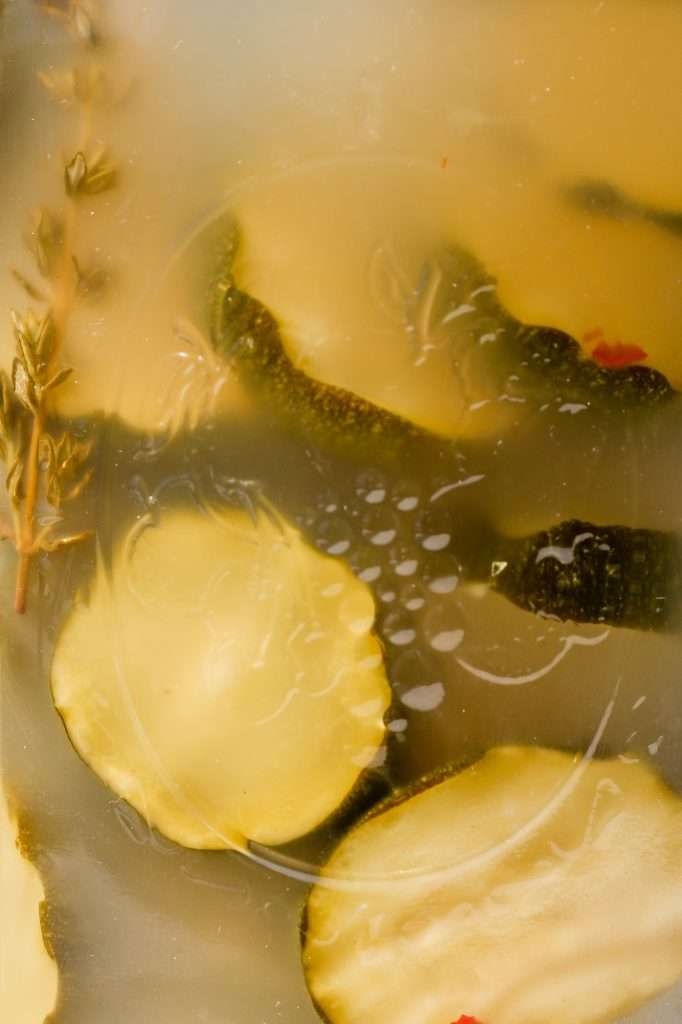
Care Guide for Fermented Squash
By following directions, you should not encounter this problem. Note that most “vine-growing” wild-fermented vegetables can have pellicle growth. This is normal for vegetables that are also fruits as long as it does not look furry, pink, blue, black, green, or magenta.
A safe pickle pellicle is normally opaque, off-white, and crinkly. If you have surface growth like this, it’s a harmless mixed colony of wild yeasts. It’s not “mold”…you can skim it off the top and still eat your pickles. See the two pictures below as a reference for what a normal pickle pellicle looks like.
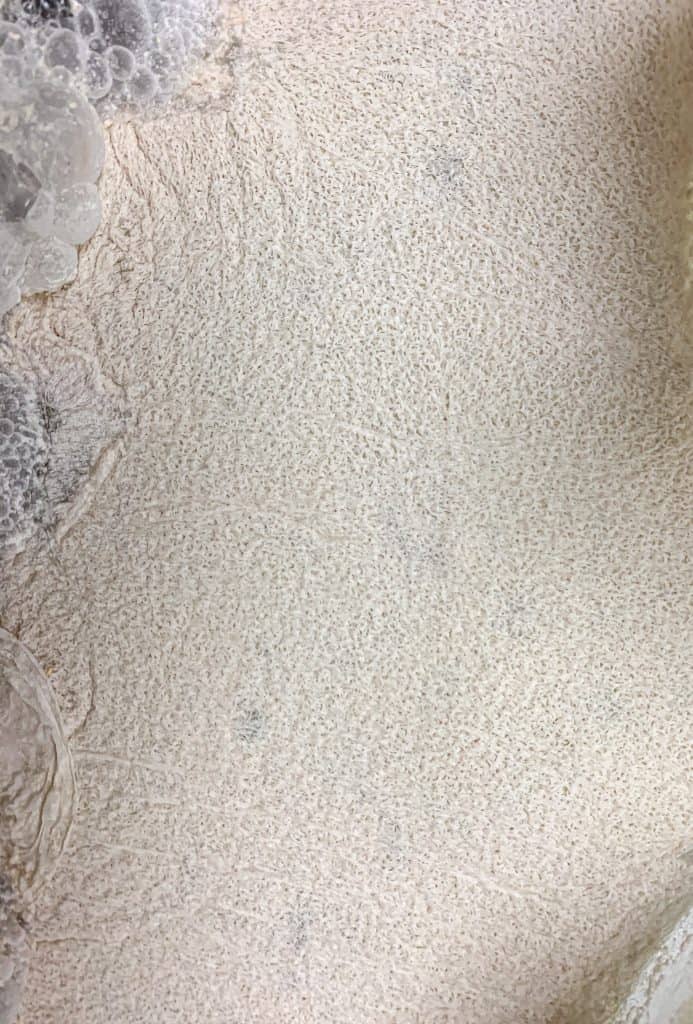

Fermented Zucchini Tips
During the first few days of fermentation: carbon dioxide and bubbles will be produced. Sometimes jars will become full of liquid, and this liquid can seep out. You can store the jar in a bowl or plate to catch anything that seeps out.
Remove the lid and tamper everything using a gloved hand, tamper, or spoon if necessary. Make sure everything remains submerged below the brine during fermentation. You can take the lid off regularly and rinse it clean if it is dirty.
Fermented zucchini should smell pleasantly sour and more smooth than a vinegar pickle. Never eat fermented vegetables that smell repulsive or like alcohol.
How Long Should I Ferment Zucchini?
See the timeline above. After two weeks, remove the fermentation weight and smell and taste test. Your fermented zucchini should smell pleasantly sour and taste similar to fermented pickles. The texture will be slightly soft since fresh zucchini already has a soft, almost spongy texture.


Fermented Zucchini Pickles with Thyme and Lemon
In the summertime in Louisiana, my favorite vegetable to ferment is zucchini! So I’m very excited to share this easy fermented zucchini recipe. I went for a light and fresh flavor with thyme, lemon, and red pepper. You can try other spices in this recipe too.
- Prep: 20 minutes
- Cook: 0 minutes
- Total Time: 20 minutes
Ingredients
- 400 grams zucchini
- 400 grams water
- 1 thin slice lemon
- 1 tsp red pepper flakes
- 1 thyme sprig
- 28 grams salt
Instructions
- This recipe at 1x works best with a 32-ounce wide mouth jar. Please see equipment recommendations above. Please use quality organic or homegrown zucchini. Recommendations can be found in the first paragraph of the blog post. Please also read the slicing recommendations.
- Wash all of your fermentation equipment (jar, weight and lid)
- Wash your zucchini in cool water.
- Slice the zucchini with a ripple cutter. (please see notes below)
- Place your kitchen scale on the counter. Turn it on and set it to weigh in grams.
- Place a mixing bowl on your kitchen scale and tare/zero the scale.
- Weigh out the designated amount of zucchini.
- Add the zucchini and the designated amount of water to the jar.
- Place a small bowl on your scale and tare/zero the scale.
- Weigh out the salt. Then add salt to the jar of zucchini and water.
- Add in all the spices.
- Place your standard mason jar lid on the jar, and secure. shake the jar vigorously for 2 minutes to dissolve all the salt.
- Remove the lid. Place your clean fermentation weight in the jar making sure to submerge the zucchini pieces and weight fully in the liquid.
- Secure the lid to the jar.
- Let the zucchini ferment for 14 days at room temperature. Set the jar in a glass dish to catch any spills.
- If using a regular mason jar lid, you will need to burp the jar daily when it is bubbling.
- After 2 weeks, remove the fermentation weight and smell and taste test. Your fermented zucchini pickles should smell pleasantly sour. They should taste tart, like a smoother version of a vinegar pickle.
Notes
- Do not expect this recipe to result in a crisp pickle texture. If using good zucchini, it will be firm, with good texture, but it will not be “crisp.” When fermenting zucchini, the texture will be naturally softer than a cucumber pickle since fresh zucchini already has a soft, spongy texture.
- If you want to ferment a large zucchini that may be overripe and has a spongy texture already, you should ferment it as a relish. Grate it into shreds and ferment it as a relish, so if it’s a little soggy, it won’t matter.
- You can add bay leaves, green tea leaves, or grape leaves to encourage firmer fermented zucchini






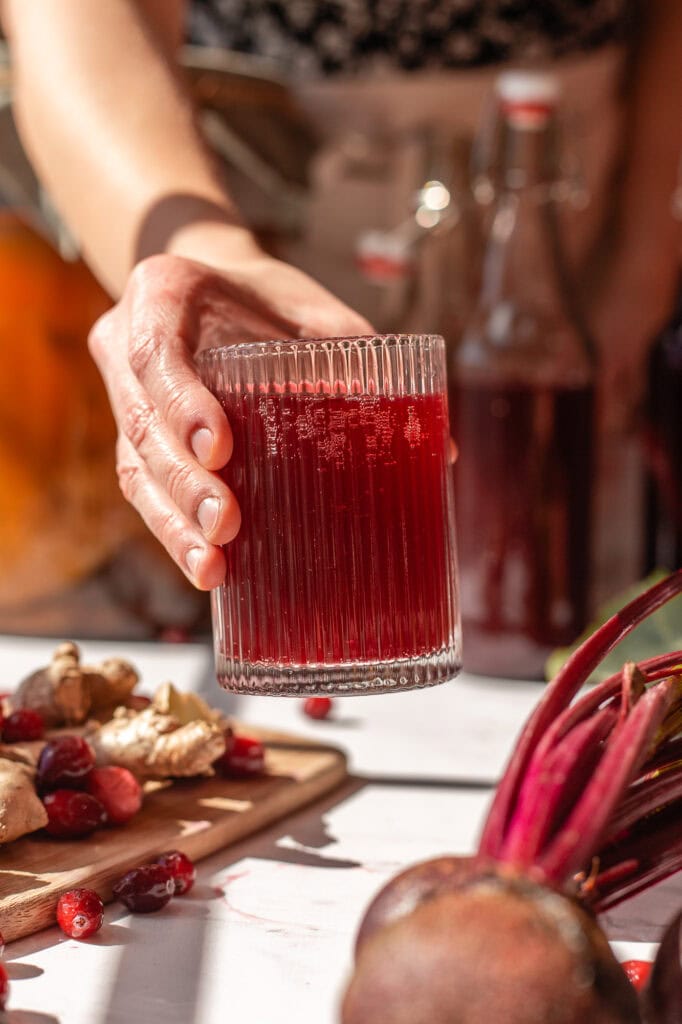










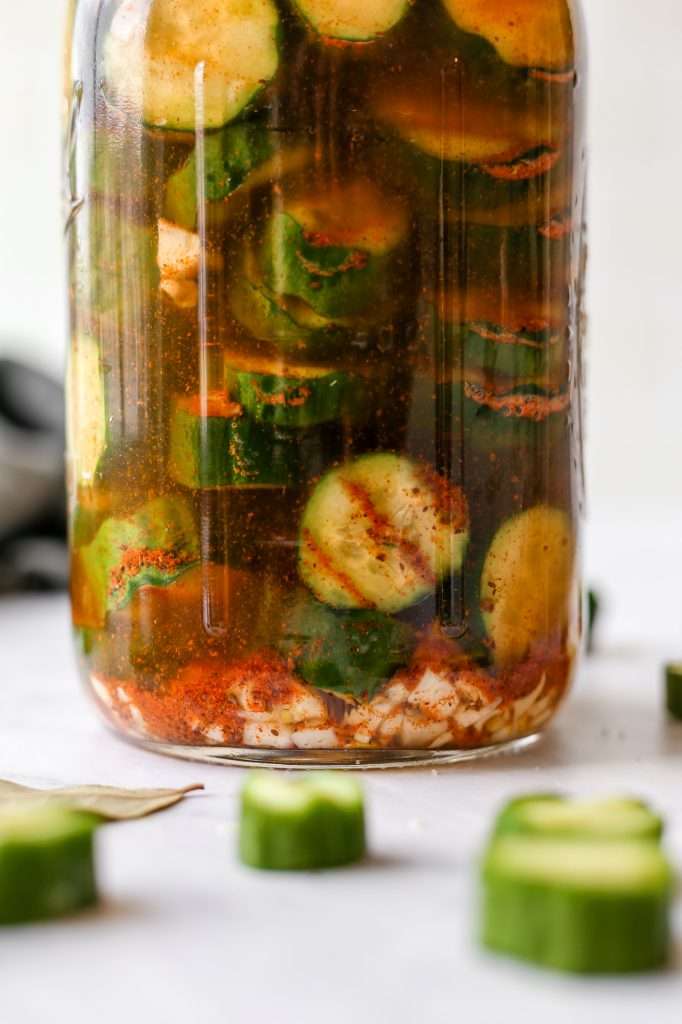


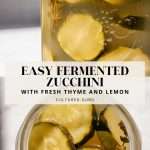
I tried this recipe with two different ways. One with added spices (garlic, black pepper and fennel seeds), and one with just salt. Both ended up with a ‘black’ film growing along the top. I smelled the ‘salt only’ product and it smelled ‘earthy’. Needless to say, I dumped both…~;(
Any idea as to what might have caused the black growth…or what the black growth might have been?
wow. I’ve never seen black growth on fermented vegetables before! It must have been fungal growth… and it’s good you dumped both. Since the growth was in both jars, it must be “environmental contamination”, meaning unclean jars and equipment. How did you clean your equipment before beginning? Did you use a clean glass fermentation weight to keep everything submerged? The only other thing that can cause this is bad zucchini. Sometimes conventionally grown “dirty” crops, like summer squash, don’t have a good enough microbiome to initiate the wild fermentation process. Conventionally grown zucchini can contain high amounts of toxic organophosphate and organochlorine pesticides, which kill a lot of microbes too.
I’m looking for uses for the zucchini kraut. I’ve used it with fried kielbasa served over mashed potatoes but looking for other possibilities.
Hey there!
I hope you’re enjoying the fermented zucchini. I suggest trying it in on a Reuben sandwich!
Hi there,
I followed the recipe and it seems to have worked out well (it’s at day 16 now). The flavour is quite salty to taste. It there anything I could do to reduce this? Perhaps replace some of the liquid with vinegar? Or simply rinse each serve in fresh water before eating it?
Thank you!
Yep! You can pour off half the liquid and replace it with vinegar then stick it in the fridge.
This is excellent flavor combination! I never would have thought to use thyme. After reading this, I realized I was not letting my vegies ferment long enough.
I’ve read this recipe twice and though appealing I would like you to add a little information. first how long the finished product keeps and 2 does it need to be kept refrigerated.
Hey there,
No problem! You can check the blog sections above the recipe card for more detailed care instructions. Once fermentation is complete at 14 days, you can store it in the fridge for 12 months.
Just finished recipe and put right into cupboard. Thanks much. I will get back two weeks from today.
I have fermented wax peppers and green beans from my garden for a few seasons now and I always use a capful of unfiltered live apple cider vinegar as a starter. I will try fermenting some home grown zucchini today. I will use the vinegar starter, but I wonder if you think it is necessary.
It’s not necessary but adding a small bit of acetic acid (vinegar) or citric acid at the start of fermentation has been proven to encourage a healthy microbial population in the fermentation. The microbes in vinegar won’t contribute much to the process, since acetic acid bacteria are aerobic and vegetable fermentation is an anaerobic process.
I never expected these to taste SO GOOD!!! I am so glad I stumbled across this recipe to use my excess home grown zucchini. It is delish! Perfect amount of heat from the chili and sourness from the ferment. Love it. Thanks all the way from Australia!
Also wanted to add it’s currently summer here and my ferment took 2.5/3 days (I have made it twice now!) to reach a nice sourness – that’s day time temps of 35-40 degrees Celsius and room temps probably 25 degrees (possibly higher) if I had to estimate. Either way much shorter than the 2 weeks suggested in the recipe which is suited to cooler temps.
so happy you enjoyed the recipe! Yes, with hot temperatures, like those in Australia fermentation can be very very quick!
Very similar to a recipie I have been using for years. We like basil, little onion, and fermented garlic as seasonings and the fermented garlic to jump start the process. I always remove the blossom end (1/4 inch) of the zucchini which can contribute to a softer finished product. Also cube the zucchini and try and cut them to a consistent size so they are all “done” uniformally. We just got to the point with our zucchini harvest that we can’t keep up so it’s time to start fermenting. Thanks for your recipie.
I have an overgrown Zucchini – I was on vacation so it didn’t get picked at its prime. They don’t taste very good when they got this big/tough. Would fermenting it be a good option? Or is it too late for that, too? Thanks for the detailed recipe!
You should try it! If they don’t taste very good cooked, then you don’t have anything to lose by making a jar and seeing how it turns out.
You’re right! I’ll give it a try! Thank you 🙂
Could I omit the lemon from this recipe? I’m very new to fermenting so just curious if it will impact the crunch/sogginess of the zucchini at all of its just for taste here.
you can omit it. It won’t change anything except the flavor.
Hello! Excited to try this out; we are newbies to fermenting (failed attempts thus far…)
I’m wondering if this can be adapted for long-term dry storage?
Thank you!
I’m excited to try this recipe! Can it be adapted for long – term dry storage?
Thank you!
To store it at room temperature, you would have to pressure can in after fermentation, killing all the microbes.
Why so much salt? Standard ratio is 2-5%, být your ratio is 6%.
No, it’s a 3% total salt concentration. 12/412 is 2.9%.
No it Is 6%. 12g in 200ml Is 60g in 1l (1000ml) = 6% IT Is calculated from water ONLY! (Brine)
No, it is a 3% TOTAL SALT CONCENTRATION. You are talking about salinity. Two different things. On this blog we account for the water inside of the vegetables as well, you know, because osmosis is a thing. You can read more about that here.
Hi Kaitlynn, love your platform. I am in proces of fermentation of zucchini acording to this recipe. On day 3 ferment started to have very strong alcohol smell. Now is day 5 and strong alcohol smell is still present. Do you thing this is yeast and ismell will go away when LAB will take over? There is no mold and everything is submerged. Would very apreciate your thoughts.
If it’s bubbling just keep burping the jar to see what happens. The smell should change the longer it ferments. Zucchini contains a lot of fructan fermentable sugars so it can smell like alcohol during the bubbling stage.
Kaithlynn, thank you so much for answer – you are right it is bubbling, and after 2 more days alcohol smell is less strong. On the other hand – there is some white sediments on the bottom like white layer – which was not there before. Is it something to be concerned about? So many questions for one small bach of zucchini 🙂
I am wondering what would happen if I added 9 grams of salt instead of the recommended 12?
might be soggier and more yeasty in flavor.
I can see that I tried to move as fast as zucchini in my garden and improvised too much during my first try at fermentation. 1. If I didn’t add enough salt, should I expect the fermentation process to progress faster? I had to start burping the jars approximately 2 days sooner and the burping ended about when it should have started based on the schedule in this post. Should I plan to refrigerate the jars sooner? 2. Does refrigeration stop the fermentation process or just slow it down? For example if I refrigerate the jars during stages 2 or 3, will they continue going through the remaining stages at a slower pace in the fridge?
Could you please let me know if it’s OK to increase the amount of vegetables and reduce the amount of water as long as I keep the amount of salt at 3% off the total amount. I am used to packing the veggies into the jar which naturally reduces the amount of space for the water. Is this OK as long as the salt is kept at 3% off the total amount of veggies + water in this recipe?
I am not sure when to remove the weight. Am I supposed to keep the weight in the jar after day 14?
You say to use 3.5% salt but the recipe given is higher than that. Is that intentional? So you recommend that higher amount but say 3.5% minimum? Just making sure because normally ferments I do are around 2/3%
I use precise total salt concentration for my recipes, not “brine salinity” or whatever it is other people do. The salt given in the recipe is right at 3.5%. 28/800 is 0.035, which is 3.5%. Zucchini is 95% water, so the weight of the zucchini is also factored in.
There is a picture here of zucchini noodles. Same recipe as pickles? I did 1/2 gallon pickles and 1/2 gal relish, but tada…more zucchini! Do you recommend noodles? Any changes?
I love using this recipe with zucchini noodles. Same recipe and directions; just cut with a spiralizer instead.
Hey there! Let’s say someone…. accidentally bought conventional zucchini for this recipe, realized it called for organic, and tried to add a capful of ACV as a starter to help it along. It’s me, I’m someone. Was that a stupid move? Only on day 2, so there’s no red flags as of yet.
All you can do is wait and see what happens! I don’t think it was a stupid move, just can’t be sure how it will turn out.
I appreciate the kindness in your reply, I was half-worried you’d say “yeah that was pretty stupid.” 😂Today’s day 7. The liquid is cloudy, have had some bubbles, I’m not seeing any weird growths, and it smells normal. All good signs, I’d think!
These are all great signs! I’d guess that the worst that can happen is they may be a little on the softer side texture wise. If the bubbles have stopped you can go ahead and put them in the fridge to age in there for a week or so before taste testing.
# 6 Directions are insulting! Really? Put the scale on a counter?
No need to be offended by clear directions. Hundreds of thousands of people use my recipes, some of them are first time kitchen scale users.